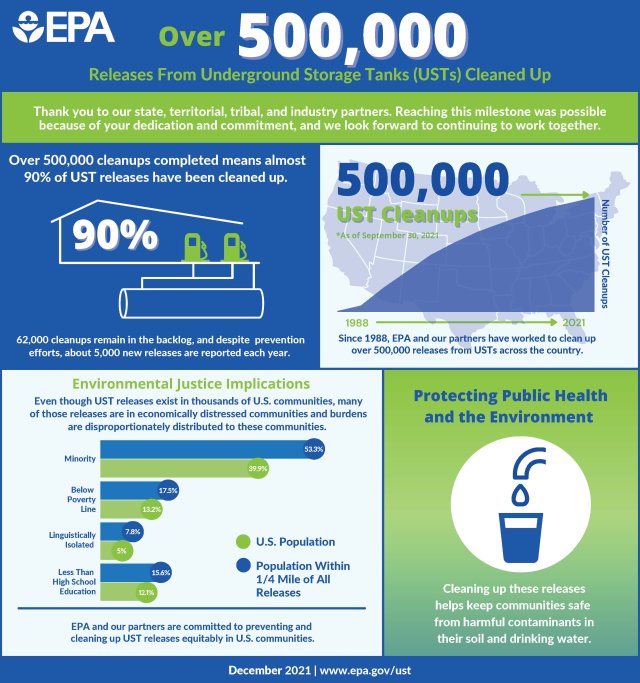EPA Thanks Partners For Achieving Milestone in Latest Issue of “L.U.S.T.Line”
More than 500,000 petroleum releases from underground storage tanks (UST) have been cleaned up since the establishment of the national UST program over 30 years ago.
According to Mark Barolo, acting director of the U.S. Environmental Protection Agency’s Office of Underground Storage Tanks, this “means that almost 90% of UST releases in our country no longer pose a threat of harmful contamination to the public’s health and our soil and groundwater.”
Barolo congratulated and thanked environmental professionals involved in the national UST program for reaching this milestone in the latest issue of “L.U.S.T.Line,” a national bulletin on underground and leaking underground storage tanks programs produced by NEIWPCC.
“During my 25 years working in the national UST program, I have witnessed firsthand the determination, dedication, and progress of all UST partners — states, territories, tribes, industry, along with U.S. EPA — in cleaning up UST releases and protecting our environment,” Barolo wrote. “I feel great pride in the program’s collective achievement. And I have a deep sense of gratitude for all the people I’ve worked with and who have contributed so significantly to the UST cleanup program’s success.”
Barolo wrote, “The national UST program’s founders built the program on the premise that our partnerships are the most effective way to address USTs in the United States. They recognized that the large size and great diversity of the regulated UST community meant we needed help with managing the huge UST universe of over 2 million tanks at the time. As a result, we have always welcomed and embraced states, territories, and tribes as our co-regulators and essential partners.”

The national tanks program was formed in 1984 as a response to public outcry about drinking water contamination from underground storage tanks that were leaking petroleum into groundwater. In addition to its model of partnerships, Barolo attributed the cleanup program’s level of success to the adoption of risk-based and site-specific corrective action strategies, and to the development of more sophisticated remediation technologies over the last 30 years.
Barolo also acknowledged the EPA’s partnerships with NEIWPCC and the Association of State and Territorial Solid Waste Management Officials, “both of which have supported our UST partnership and the national UST program by sponsoring the National Tanks Conference, educational training, and informative seminars.” The 27th National Tanks Conference will take place this September in Pittsburgh, Pennsylvania. The event brings together hundreds of tanks professionals to network and learn about emerging issues, policy, and technology.
The 90th issue of “L.U.S.T.Line” also features articles from Shannon Williams Cala, Montana Department of Environmental Quality (“The Tale of a Legacy Release: A Montana Case Study”); Mike Pecorelli, Utah Department of Environmental Quality (“The Cracked Case of the Fiberglass Tank’s Disappearing Gasoline”); Joe Cunningham, Rhode Island Department of Environmental Management (“Potential Implications of the Presence of PFAS at LUST Sites”); and Mac Pointer, Tennessee Department of Environment and Conservation (“Expect the Unexpected: Pump Explosion In Tennessee”). It also includes an interview with Rick Long of the Petroleum Equipment Institute reflecting on his career in the tanks industry.